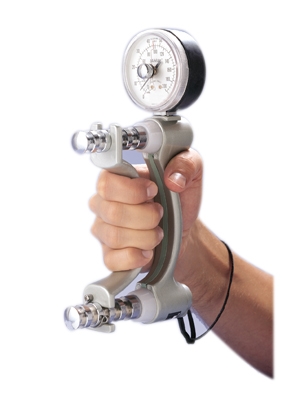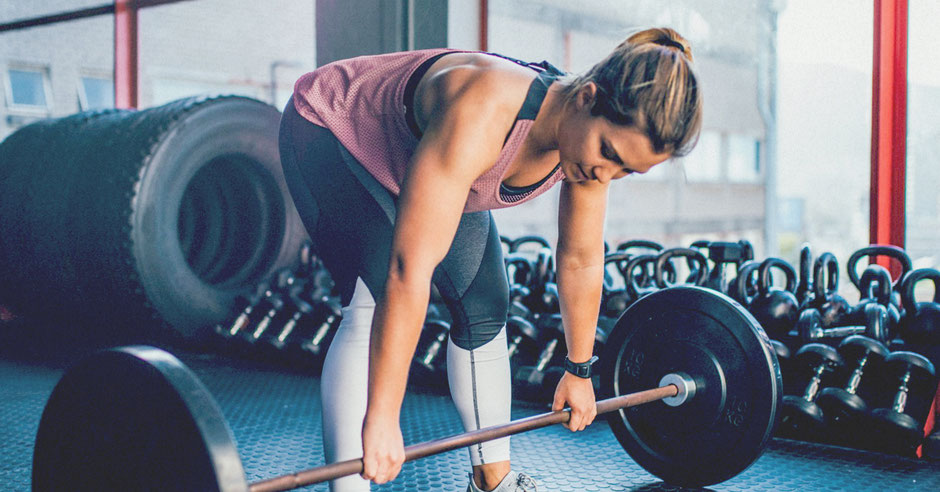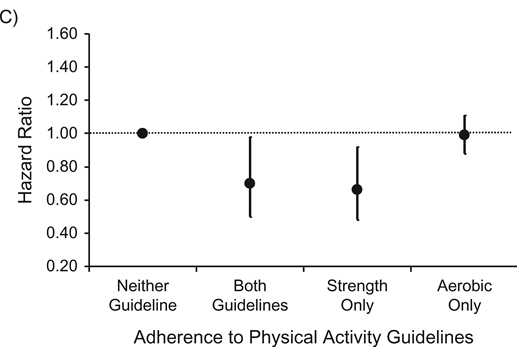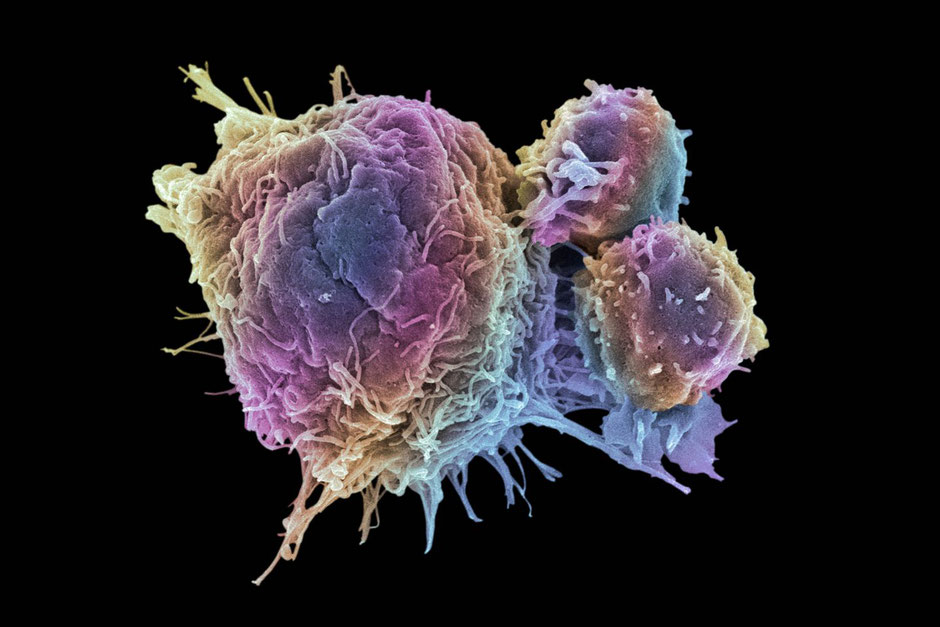We’ve recently looked at how strength training is one of the most beneficial forms of exercise for fat loss, protecting your precious brain cells, for getting the most “bang for your buck” in terms of the amount of time available you have to train and for avoiding injuries. However, we’ve yet to turn the spotlight on whether or not it is beneficial for reversing chronic disease, and in particular for preventing cancer. From our knowledge of looking at serious issues, such as cardiovascular disease, diabetes and cancer from a biochemical and metabolic perspective it is obvious that it is. However we’ve yet to back this up with scientific evidence from the medical community. Until now…

|
Did you know? Strength training = weight training = resistance training ≠ body building. When you lift a dumbbell close to your maximum capacity you can only do it few times, say 4 or 5 times, before you tire and have to put it down – that’s strength / weight / resistance training. That's not body building. With body building, you are using lighter weights that you may move 8 to 12 times in order to rip your muscles apart so they can repair and get bigger for the purpose of swimsuit aesthetics and vanity! |
||
Bruce Lee: strong, super lean and not bulky - strength training not body building
Strength training and longevity
So let's go straight to the meat of this topic without messing about. The key things we are interested in is improving both quality of life and longevity. We certainly live longer than we used to thanks to medical interventions but the average quality of life in the Western world is deteriorating rapidly with many people spending their golden retirement years on a cocktail of medical drugs due to a boat load of symptoms and in constant fear of the next doctor’s visit.
Longevity study 1

In this first study1, they took 103 older patients aged 60 and over with advanced colorectal, prostate, or breast cancer and recorded their muscle mass and grip strength (grip strength, in scientific studies, is often used as a proxy for overall strength) before issuing palliative chemotherapy. What they found was that higher muscle strength was associated with longer overall survival rate but muscle mass was not. And just to be clear building muscle mass (body building) and strength (think lean but strong Bruce Lee) are two totally different things.
“Higher muscle strength at the start of palliative chemotherapy is associated with significantly better overall survival in older patients with advanced cancer.”
Longevity study 2
Next up was a slightly larger study2 of half a million Brits published in 2018 in the very prestigious British Medical Journal. Yes that’s 500,000 people! So pretty damn conclusive. All participants were aged between 40 and 69 years and were assessed for all cause mortality as well as incidence of and mortality from cardiovascular disease, respiratory disease, chronic obstructive pulmonary disease, and cancer (all cancer, colorectal, lung, breast, and prostate). They measured their grip strength and looked at what a 5kg difference makes. That’s the equivalent of being able to throw a 25kg bag, one-handed, onto the check-in conveyor-belt at Changi Airport or only being able to throw on a 20kg bag.
The difference this 5kg in grip strength makes is nothing short of stunning:

Now considering how prevalent chemotherapy is in the treatment of cancer it’s difficult to find good quality studies on the efficacy of chemotherapy in prolonging patient lifespan. In this study3, they found that the overall contribution of chemotherapy to 5-year survival in adults was estimated to be 2.3% in Australia and 2.1% in the USA.
So would you like to increase your chances of beating cancer by 15% to 20% by lifting a few weights or undergoing hundreds of thousands of dollars worth of toxic chemotherapy that will increase your chances of survival by a mere 2.1%? Taking also into consideration that one fifth of all Singaporeans die from pneumonia4 one could engage in some strength training to increase your chance of survival by a whopping 24%. This is really nothing short of astounding and must be hands down more efficacious than any other generalised drug or alternative therapy on the market. Interestingly, it is commonly held that 80% of oncologists will not take chemotherapy if they suffer from cancer themselves!

“Muscle weakness (defined as grip strength <26 kg for men and <16 kg for women) was associated with a higher hazard for all health outcomes…higher grip strength was associated with a range of health outcomes and improved prediction of an office based risk score.”
Longevity study 3
And finally in this study5 they looked at 28,879 women in the US with an average age of 62. Measuring their strength and then taking a look at them 12 years later. What they found was that those that strength trained between 20 mins and 60 minutes a week increased their survival chances of dying from anything by up to almost 30%. Again that is a phenomenal result.

“A moderate amount of time in strength training seemed beneficial for longevity, independent of aerobic activity.”
It should be noted however that those that trained more than 150 hours a week seemed to have a detrimental affect. This makes sense. You can have too much of a good thing and exercising too much causes too much physical stress on a usually emotionally stressed body which results in down regulation of the immune system and increased chance of disease.
How does strength training compare with other forms of exercise?
In a study6 of over 80,000 Australians published in the American Journal of Epidemiology they looked at gym based strength exercises, bodyweight exercises, non-strength based aerobic activity (such as running) and their impact on all cause mortality and cancer. The results are again stunning and I have lifted the highlights directly from their paper.

So first I got these results from the text - and I read through the whole paper. OK let me explain them. See that number 0.66? What that means is that in this study those that did a strength training programme had a hazard ratio of 0.66. Or only a 0.66 chance of dying vs those that did nothing which is always set at 1.00. If we subtract this number from 1 and add a % it becomes even clearer: 1 - 0.66 = 34%. So you have a 34% less chance of dying from cancer if you embark on a strength training programme according to this study.
Curiously one of the results was missing and I wonder why. It was mentioned nowhere in the text or the tables but the researchers clearly had the data because I saw it in one of the appendix graphs. So I helpfully added that in for you here. It's the number in red.

Hmmm. Lets put those hazard ratios in percentages.

This is the clearest way of reading the data. If you embark on a pure strength training programme you have a 34% chance greater chance of surviving cancer than if you don't. For those that embarked on an aerobic exercise programme (as recommended by governments and oncologists around the world) they increased their chances of preventing cancer by an absolutely pathetic 1% - that’s even less efficacious than chemotherapy (3% efficacious for late stage cancer patients). To me that is an amazingly large difference between aerobic and strength training. The researchers decided to call this paper a snooze-inducing, “Does Strength-Promoting Exercise Confer Unique Health Benefits? A Pooled Analysis of Data on 11 Population Cohorts With All-Cause, Cancer, and Cardiovascular Mortality Endpoints. 2018.” If they had had a bit more of a tabloidy journalistic streak in their blood they could have called it, "Strength training 34 times more effective for preventing cancer than aerobic exercise like jogging or running.”
And here is the actual graph from the paper.

"Strength promoting exercise has been shown to be associated with reduced risk of fatal and nonfatal myocardial infarction among adult men and reduced risk of all-cause mortality in cancer survivors, and recent studies have also shown reductions in all-cause mortality among adults who meet the guidelines of 2 sessions per week."

“As such, strength training appears to promote benefits that may be specific to cancer types. Strength was the only consistent outcome that improved in all cancer survivors. However, these gains in strength are still of tremendous importance, given its impact on functionality and quality of life.”
Hanson ED, 20167
Don't just extend your lifespan but also increase your quality of life in your golden years
In these two studies8,9 they looked at exactly that…
"Our results showed that muscle strength was an important factor for improving quality of life in cancer survivors. We believe that the findings of this study will be relevant in the context of planning rehabilitation for cancer survivors.”
and…
“We conclude that a supervised, high-intensity strength training program seems to be an effective mean to improve muscle strength, cardiopulmonary function, and health-related quality of life and should be incorporated in cancer rehabilitation programs.”
How is strength training cancer protective
What I find interesting, and frustrating, about scientific studies is that they rarely provide you with the mechanisms behind why something works or at least even theorise on it. So we’ve added some colour here based on our own knowledge of cellular biology and metabolism.
1. Insulin sensitivity and obesity
One of the tests for cancer is to give you a radioactive glucose solution to drink and then give you a positive emission tomography (PET) scan. The glucose finds the cancer cells and lights them up like a Christmas tree. Why? Because cancer cells have 20 times more insulin receptors than normal cells! So the glucose heads preferentially to feed the cancer cells rather than normal cells.
“Cancer loves sugar!”
Strength training increases the amount of insulin receptors in your muscles hence limiting the growth of cancerous cells by diverting sugar away from the cancer to the muscles. Of course cutting down on sugar will help too!10

2. Immune system boost
In this study11 they identified stronger immune systems in people with increased handgrip strength, one-repetition maximum chest press and knee extension tests.
“…overall survival is significantly reduced in people with weaker and smaller skeletal muscle. We have identified significant correlations between levels of T cell populations and muscle strength, performance, and body composition in people with cancer.”
This is obviously super useful because a boosted immune system can spend more time hunting down and attacking cancerous cells in our bodies with (awesomely named) macrophages and T-killer cells.
3. Estrogen and toxicity
Many cancers can be exacerbated by imbalanced hormones such as estrogen dominance. Estrogen is an anabolic (building) hormone so too much of it floating around will be sending too many building instructions to things that you don’t want built, i.e. cancers in the breasts. Exercise, such as strength training, removes excess estrogen from circulation via the liver. And additionally to that any kind of movement that helps move lymphatic fluid and toxins around the body and into your waste disposal unit is a good thing.

4. Minding your mitochondria
You have trillions of cells in your body and each one has a little power pack or battery called mitochondria. The metabolic theory of cancer is that cancer is a result of faulty mitochondria that can no longer respirate aerobically (with oxygen) and has resorted to back-up power. A cancer loving mechanism referred to as glycolysis or the fermentation of sugars for energy. Strength training improves mitochondrial efficiency in skeletal muscles which boosts aerobic respiration at the cellular level and is the enemy of cancerous cells that depend on sugar for energy and die in the face of oxygen.
5. IGF-1 and mTOR
No need to worry what these are but the over-consumption of protein can inflate Insulin-like growth factor 1 (IGF-1) and mammalian target of rapamycin (mTOR) which can fuel cancer growth. Much better to engage in strength training that stimulates our muscles to take up excess protein rather than the cancer cells. Of course if we eat less but better quality protein that can also help but most people are so out of touch with their innate ability to determine when enough is enough that this is far easier said than done!
Wrapping up
So to wrap up it seems there is a wealth of compelling evidence that strength training works as an effective cancer prevention strategy but body-building and cardio is not. Training twice a week works but don't overdo it. It also appears that strength training is also good for a bunch of other issues such as protecting oneself from cardiovascular and respiratory events.
Let's put this together into a recommend plan of action:
1. Get some strength training into your life if you want to live longer, reduce your chances of getting a disease and to improve your quality of life.
2. For older people (60+) we recommend between 1 and 2 strength training sessions a week. If once a week then the sessions should have at least 20 minutes of strength training. And if training twice a week a typical 60 minute training session should be divided into stretching, mobility & flexibility work, corrective exercise with only a portion dedicated to strength so as not to exceed the 60 minute threshold. For younger people and the less stressed you can train more frequently.
3. If you like aerobic exercise - brilliant. Just add a little strength training to your programme for balance. If you enjoy cardio then feel free to stop immediately and switch to something far more beneficial from a health perspective.
4. This study12 says it’s better to do it with a friend!
“Exercising Together is a novel couples-based approach to exercise that was feasible and improved several health outcomes for both prostate cancer survivors and their spouses.”
5. And finally coupled with good quality nutrition, a great night’s sleep and some stress reduction techniques you have your personal recipe for taking back control of your health so you never have to fear that doctor’s visit again!
To your health, happiness and longevity,
The Levitise Team
P.S. If you love this blog post then do check out our fortnightly newsletter where you'll get the freshest content on health, nutrition and fitness delivered straight to your inbox. Don't miss out and sign up here with just your name and email.
1. Higher Muscle Strength Is Associated with Prolonged Survival in Older Patients with Advanced Cancer, 2018. https://www.ncbi.nlm.nih.gov/pubmed/29222198
2. Associations of grip strength with cardiovascular, respiratory, and cancer outcomes and all cause mortality: prospective cohort study of half a million UK Biobank participants, 2018. https://www.bmj.com/content/361/bmj.k1651
3. The contribution of cytotoxic chemotherapy to 5-year survival in adult malignancies, 2004. https://www.ncbi.nlm.nih.gov/pubmed/15630849
4. https://en.wikipedia.org/wiki/death_in_singapore
5. Strength Training and All‐Cause, Cardiovascular Disease, and Cancer Mortality in Older Women: A Cohort Study, 2017. https://www.ncbi.nlm.nih.gov/pmc/articles/PMC5721806/
6. Does Strength-Promoting Exercise Confer Unique Health Benefits? A Pooled Analysis of Data on 11 Population Cohorts With All-Cause, Cancer, and Cardiovascular Mortality Endpoints, 2018. https://academic.oup.com/aje/article/187/5/1102/4582884
7. The Independent Effects of Strength Training in Cancer Survivors: a Systematic Review, 2016. https://www.ncbi.nlm.nih.gov/pubmed/27025505
8. Cancer survivors exhibit a different relationship between muscle strength and health-related quality of life/fatigue compared to healthy subjects, 2018. https://www.ncbi.nlm.nih.gov/pubmed/29767832
9. High-intensity strength training improves quality of life in cancer survivors, 2007. https://www.ncbi.nlm.nih.gov/pubmed/17851864
11. Cancer-driven changes link T cell frequency to muscle strength in people with cancer: a pilot study, 2019. https://www.ncbi.nlm.nih.gov/pubmed/30977974
12. Benefits of partnered strength training for prostate cancer survivors and spouses: results from a randomized controlled trial of the Exercising Together project, 2016. https://www.ncbi.nlm.nih.gov/pubmed/26715587
Additional studies not mentioned in this article:
* Association of Grip Strength With Risk of All-Cause Mortality, Cardiovascular Diseases, and Cancer in Community-Dwelling Populations: A Meta-analysis of Prospective Cohort Studies. (American Journal of Epidemiology, 2018)
* Association of Muscle Strength and Incidence of Cancer in Men. (British Journal of Cancer, 2018)
* Physical Activity and Risk of Breast, Endometrial, and Ovarian Cancers in the European Prospective Investigation Into Cancer and Nutrition (EPIC) Study. (International Journal of Cancer, 2015)
* Pre- and Postdiagnosis Body Composition and Survival in Women With Breast Cancer: Lean Mass After Diagnosis Is Associated With Survival. (Journal of Clinical Oncology, 2019)
* Hand Grip Strength and Cause-Specific and Total Mortality in Older Adults: The EPIC-Elderly Prospective Cohort Study. (European Journal of Epidemiology, 2020)




Write a comment